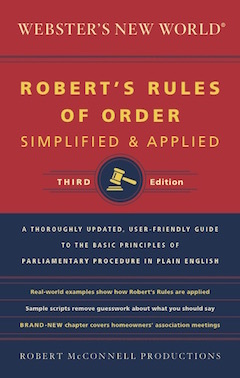Standing Rules as one type of Governing document of an Organization
Volume 6, Issue 3, March, 2000
drvideo@comcast.net
STANDING RULES
By Robert McConnell Productions
In the previous "Parliamentary Internet Newsletters," we’ve discussed bylaws, corporate papers, and rules of order. Another set of rules that organizations find helpful are those called "standing rules." These are rules concerning the administration of the organization. Robert’s Rules of Order Newly Revised, 9th ed. states that the time for a meeting is put in the standing rules instead of the bylaws.
These rules are considered main motions. They do not need previous notice to be adopted by a majority vote. They can be suspended for the duration of a meeting and can be rescinded without previous notice by a two-thirds vote, and majority vote with previous notice. These rules remain in effect until the assembly rescinds them.
When an organization adopts motions that are for a lasting duration, the secretary should add them to a book entitled "Standing Rules". Each motion should be recorded in its final version as adopted and the date it took effect. If the rule is later rescinded, the secretary should strike it out and make a notation when it was rescinded. By keeping a record of these motions, each new administration will know what they are required to do. It will keep continuity in the organization instead of new members perpetually having to ask long time members what to do and when.
If an organization does things "because that is always the way it has been done", then these customs should be written down so that everyone knows what to do. A custom becomes a force of law and needs a formal motion to rescind it just as if the assembly had enacted it. Perhaps the assembly enacted it many years ago, but members have forgotten this fact.
Some examples of standing rules might be:
1. a guest register at the meetings
2. a particular donation given to an organization at a certain time of year
3. wearing name tags or special pins at meetings
4. who is responsible for introducing guests
5. a specific month for the annual picnic
6. the time for the meeting
7. the place for the meeting
8. who should take the minutes in the absence of the secretary
9. motions of long term affect
10. who is responsible for opening up, setting up the meeting, etc.
SUSPENDING STANDING RULES
When members can’t do something without violating the rules of the organization, Robert’s Rules has provided the incidental motion "suspend the rules" to allow them to set aside the rule so that they can go forward with the desire action. Both "rules of order" and "standing rules" can be suspended. Bylaws can not be suspended unless they provided in the bylaws for their suspension. However, any rules of order in the bylaws can be suspended.
Rules of order are suspended by a two-thirds vote. However, standing rules can be suspended by a majority vote because they do not involve the protection of a minority.
In the organization of Toastmasters, some chapters have a rule that members must pay a nickel for every "ah" or "um" or other such phrase that they say during the meeting. It is a way for the chapter to make some additional cash since most of the dues go to the national organization. Let’s say at a particular meeting the person who is in charge of this position is not present and no one else is prepared to do the job (which is unheard of in this organization). A member could rise, address the chair and state:
MEMBER: Madam President,
PRESIDENT: [states member’s name]
MEMBER: I move to suspend the rule that we collect money for each "ah" and "um" at tonight’s meeting.
MEMBER 2: Second.
PRESIDENT: It is moved and seconded to suspend the rule that we collect money for each "ah" and "um" at tonight’s meeting. All those in favor say "aye". Those opposed say "no". The ayes have it and the rule that we collect money for each "ah" and "um" at tonight’s meeting is suspended for the duration of the meeting.
This motion needs a second and is not debatable. When it is proposed and seconded the chair immediately takes a vote.
